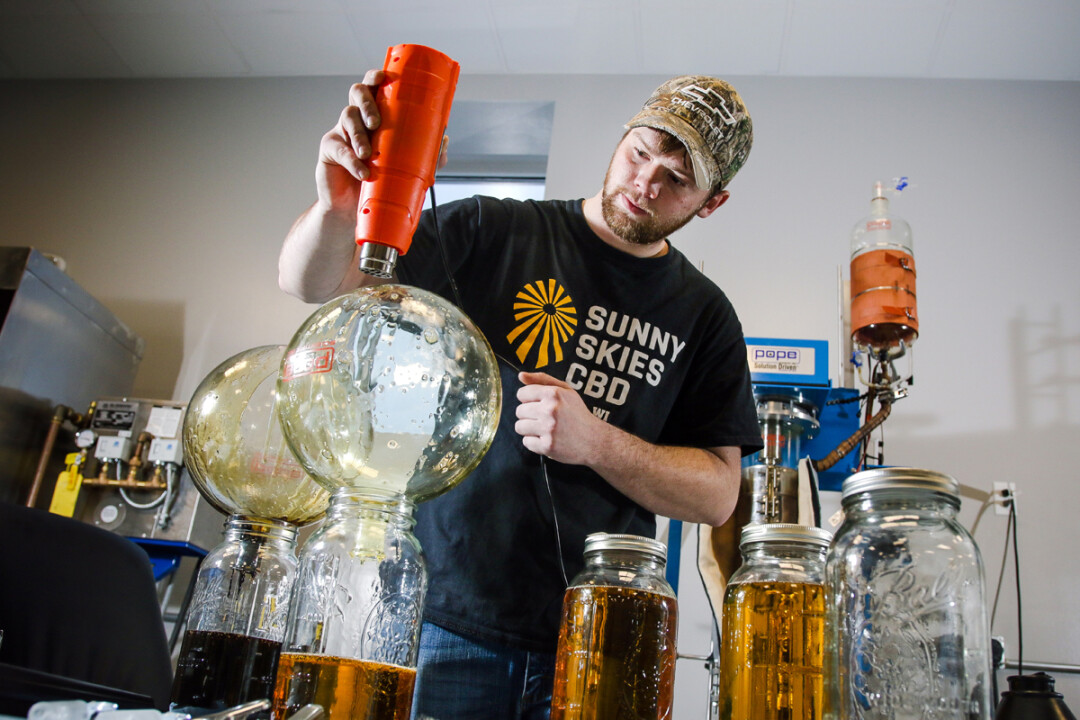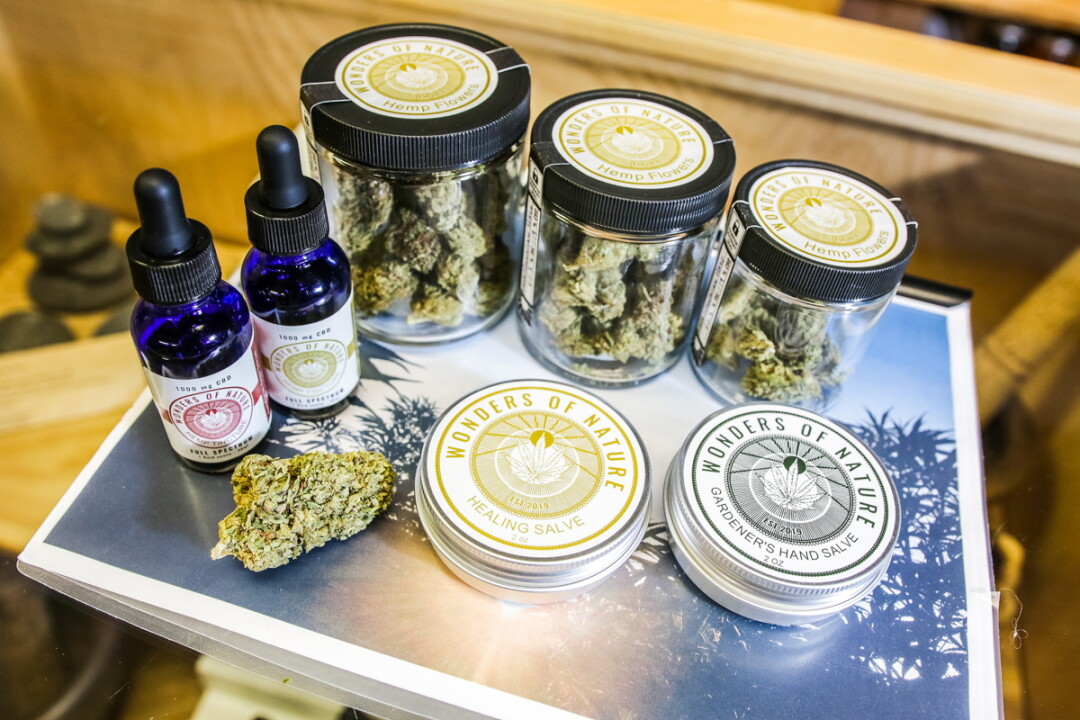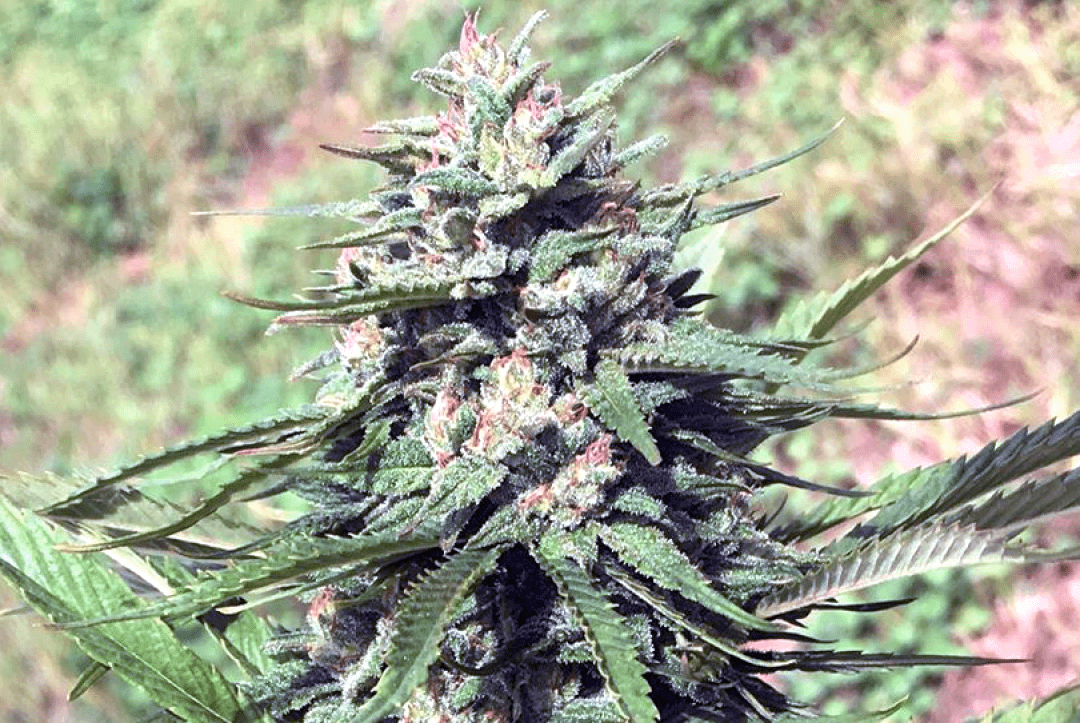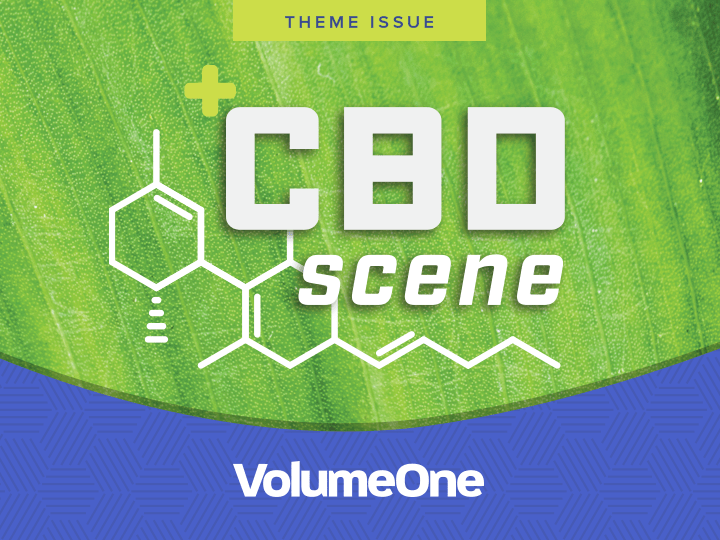UPDATED: The FAQ on CBD
everything you wanted to know about CBD, but didn’t know who to ask
Tom Giffey, photos by Andrea Paulseth

FIRST THINGS FIRST: WHAT EXACTLY IS CBD?
CBD is an abbreviation for cannabidiol, a chemical compound found in the cannabis plant. CBD is one of more than 100 identified cannabinoids. In recent years, it has been promoted as a treatment for a wide range of health concerns, including anxiety, chronic pain, insomnia, seizures, and more. It is available for sale legally in Wisconsin in the form of a distilled oil and in numerous other products.
SO THIS COMES FROM THE SAME PLANT AS MARIJUANA?
Not really. CBD is derived from what is known as industrial hemp, which is a relative of marijuana. Scientifically speaking, both industrial hemp and marijuana are classified as strains of cannabis sativa. While the two kinds of cannabis may look similar – tall, green, and with easily recognizable long-lobed leaves – chemically they are very different. Industrial hemp contains a lot of CBD but very little THC (tetrahydrocannabinol), the active ingredient in recreational and medical marijuana. Specifically, to be grown legally in Wisconsin, cannabis plants must have less than 0.3% THC content.
SO CBD DOESN’T GIVE PEOPLE A HIGH?
No, it won’t. While marijuana does contain CBD, it’s the THC that gives that kind of cannabis its psychoactive kick. Because it has such a negligible amount of THC, consuming – even smoking – industrial hemp won’t get you high. In fact, CBD can actually inhibit the impact of THC.
WHY DOES IT SEEM LIKE CBD IS EVERYWHERE THESE DAYS?
Laws and regulations governing cannabis have been in flux at the federal and state levels. In Wisconsin, CBD possession was legalized in 2017, and in 2018 farmers began growing cannabis under the state’s industrial hemp pilot program. Since then, CBD products have appeared on store shelves and a growing number of farmers have cultivated cannabis for a variety of commercial purposes, including CBD production and use for fiber and food.

WHY DO PEOPLE USE CBD?
According to Dr. Rachna Patel, author of The CBD Oil Solution, CBD “has been shown to reduce inflammation, intercept pain signals to the brain, boost serotonin levels, dampen the flight-or-fight response, and help regulate sleep.” CBD has been promoted as an alternative therapy for a variety of ailments, including chronic pain, anxiety, insomnia, migraines, menstrual cramps, post-traumatic stress disorder, neuropathy, Parkinson’s disease, multiple sclerosis, and more. For such uses, it is sold as a dietary supplement, not a prescription medicine, so it is not regulated by the U.S. Food and Drug Administration. The only FDA-approved medical use of CBD is a pharmaceutical drug called Epidiolex, which was OK’d in 2018 to treat two severe forms of epilepsy. Research is ongoing about the medical effects of CBD. According to Dr. Peter Grindspoon of Harvard Medical School, a study found that “CBD applied on the skin could help lower pain and inflammation due to arthritis. Another study demonstrated the mechanism by which CBD inhibits inflammatory and neuropathic pain, two of the most difficult types of chronic pain to treat. More study in humans is needed in this area to substantiate the claims of CBD proponents about pain control.”
HOW DOES CBD WORK?
CDB interacts with what is called the endocannabinoid system within our bodies. This system can impact our mood, memory, appetite, perception of pain, and more, and it is impact by substances both produced inside our bodies and outside them (such as CBD and THC). THC fits snugly into certain cannabinoid receptors, causing the brain to release dopamine, which causes a high. CBD molecules also fit into the same receptors, but not in the same way as THC. This causes particular chemical reactions in the body, but not a THC-driven high.
IS CBD ADDICTIVE?
No. According to a 2017 report by the World Health Organization, “In humans, CBD exhibits no effects indicative of any abuse or dependence potential. ... To date, there is no evidence of public health related problems associated with the use of pure CBD.”
CAN CBD HAVE SIDE EFFECTS?
Yes, it can. “Side effects of CBD include nausea, fatigue, and irritability. CBD can increase the level in your blood of the blood thinner coumadin, and it can raise levels of certain other medications in your blood by the exact same mechanism that grapefruit juice does,” writes Dr. Peter Grindspoon of Harvard Medical School. CBD can also impact the metabolism of some chemotherapy treatments, according to Dr. Brent Bauer, director of the Mayo Clinic Integrative Medicine and Health Research Program. Bauer advises that people talk to their health care providers about using CBD. “I’m very optimistic that there will be something beneficial there,” Bauer said in Mayo Clinic News Network video. “I don’t think it’s going to be magic.”
WHAT KIND OF PRODUCTS CAN I FIND CBD IN?
CBD is available in a myriad of over-the-counter products. Most commonly, it’s sold as an oil, which is extracted from the cannabis plant and tested to ensure its THC content is below 0.3%. This oil can be added to topical creams and salves, gummies bath bombs, breath sprays, inhalables – the list goes on.

WHO GROWS CBD-PRODUCING HEMP?
An increasing number of Wisconsin farmers. There were 180 licensed and registered growers in the state in 2018, according to the Wisconsin Department of Agriculture, Trade, and Consumer Production. In 2020, by contrast, there were 1,248 registered growers, 850 of who planted a crop – an increase of nearly 600%. Those farmers grew about 5,400 acres of industrial hemp in 1,225 locations, which means the average hemp growing operation was just a few acres.
WHAT ELSE CAN INDUSTRIAL HEMP BE USED FOR?
Hemp has a myriad of uses. According to a 2018 report by Congressional Research Services, there are an estimated 25,000 products derived from hemp in nine categories: agriculture, textiles, recycling, automotive, furniture, food and beverages, paper, construction materials, and personal care. You can find hemp in everything from twine, diapers, and fiberboard to salad oil, birdseed, animal bedding, and shampoo.
IS HEMP SOMETHING NEW IN WISCONSIN?
Not at all. Before the industrial hemp industry was essentially obliterated by anti-drug laws, Wisconsin was a top hemp state. According to a 2019 article by the Wisconsin Center for Investigative Journalism, “In the early 1940s, Wisconsin led the country in the production of hemp. University researchers began growing hemp in 1908, and by 1917, farmers had 7,000 acres under cultivation. During World War II, demand for hemp increased due to its utility for making rope. At one point during the war, Wisconsin had 42 hemp mills across the state.” The last legal hemp grower in the nation was the Rens Hemp Co. of Brandon, Wisconsin, which grew its last crop in 1957.
IF CBD IS LEGAL IN WISCONSIN, WILL RECREATIONAL MARIJUANA BE NEXT?
That’s unclear. Proposals to decriminalize marijuana in Wisconsin have gone nowhere. In his state budget in 2019, Gov. Tony Evers, a Democrat, proposed legalizing medical marijuana and decriminalizing possession of up to 25 grams of marijuana for recreational use. However, the Republican majority in the state Legislature removed those provisions from the budget. Meanwhile, medical marijuana is legal in three of Wisconsin’s border state (Minnesota, Illinois, and Michigan) and recreational marijuana use has been legalized in two of them (Michigan and Illinois).

